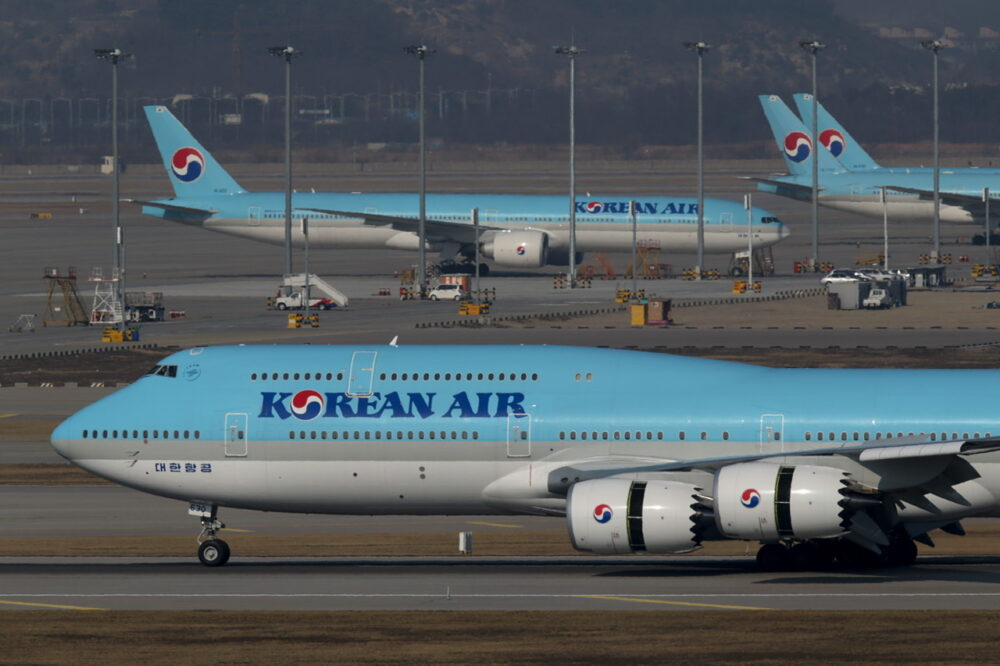As revealed last week, Korean Air expects to retire its A380s by 2026 and its Boeing B747-8s (at least its passenger aircraft, anyway) by 2031. The withdrawal of its A380s will include Asiana’s three aircraft, which it’ll inherit after the two carriers merge. Like many other airlines, Korean Air is betting its future on smaller and more fuel-efficient twin-engine aircraft.

Korean Air’s A380s
Korean Air has ten A380s with an average age of 9.4 years, ch-aviation.com shows, with the type first used in 2011. All are owned rather than leased. However, only one aircraft is active, registered HL7614. This example, delivered in September 2011, currently only operates between Seoul Incheon and Guangzhou, a sub-three-hour service.
Each A380 is configured in a 407-seat layout with 12 in first, 94 in prestige (business), and 301 in economy. The type has the largest first-class and prestige class of any aircraft in its fleet, although the B747-8 has more in economy.
From now until the end of the year, Bangkok, London Heathrow, Los Angeles, New York JFK, and Paris CDG are all scheduled to see the return of the A380. However, it is far from certain whether they will. They’re much more likely to return in 2022, subject, as ever, to the pandemic.

One of three passenger users of the B747-8
Korean Air is one of only three users of the Boeing 747-8 in passenger configuration (IATA code: 74H), along with Lufthansa and Air China. The South Korean airline began using them in 2015 and has 10 in all, along with seven freighters.
Its passenger -8s have an average age of just 5.3 years, ch-aviation.com indicates, with half of them owned and the rest with operating leases. They have 368 seats: six in first, 48 in prestige, and 314 in economy. Interestingly, 15% of Korean Air’s B747-8s seats are premium against 26% for the A380; you can see why given most of its destinations.
Auckland, Chicago, Honolulu, Kuala Lumpur, Heathrow, JFK, Prague, Rome, Singapore, and Sydney were all expected to see the aircraft between now and New Year’s Eve. However, most aren’t bookable; they’ve either been changed to other types or zeroed out. Some are bookable, such as Prague.

The USA has been crucial for the A380
Korean Air’s first scheduled A380 flight took off on June 17th, 2011, from Incheon to Hong Kong and Tokyo Narita, with Beijing, Los Angeles, New York JFK, and Paris CDG also seeing the type that first year.
Since 2011, the quadjet has been used to 14 destinations, with the list below the photo based on total flights. Los Angeles has seen it the most, with one-fifth more services than JFK.
Korean Air began Los Angeles on October 11th, 2011, with the A380 operating once-daily year-round until October 26th, 2013, after which it was twice-daily. With 62% of all A380 flights in the past decade, the A380 has revolved around the USA.

- Los Angeles
- New York JFK
- Paris CDG
- Hong Kong
- Bangkok Suvarnabhumi
- Atlanta
- Sydney
- London Heathrow
- Frankfurt
- Tokyo Narita
- Taipei
- Guangzhou
- Beijing Capital
- Prague
from Simple Flying https://ift.tt/3muGTjE
via IFTTT
Comments
Post a Comment